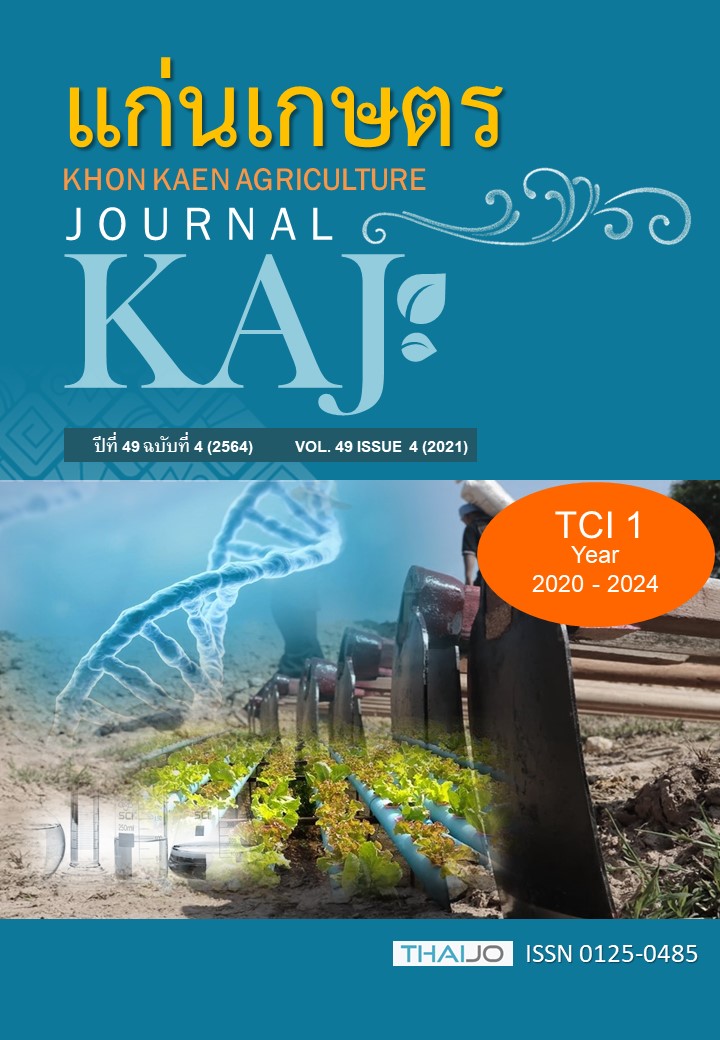Genetic variability and heritability in commercial tenera oil palm
Main Article Content
Abstract
Vegetative characters and yield components are quantitative traits which environmental strongly effects on the expression of them. The objective of this study was to evaluate the performance of commercial tenera oil palm, genetic variability and broad–sense heritability (h2b) as well as phenotypic and genotypic coefficients of variation for vegetative characters, such as leaf area (LA), leaf dry weight (LDW) and rachis length (RL), and bunch yield, such as fresh fruit bunch (FFB), bunch number (BN), average bunch weight (ABW) and oil yield (OY). Six commercial tenera oil palm progenies were planted at Oil Palm Collection Center, the Chaipattana Foundation at Trang province. The experiment was arranged in a randomized complete block design (RCBD) with three replications. Data were collected from each commercial tenera oil palm after field planting for one year. The result showed that vegetative characters and bunch yield had significant difference among the progenies, except OY and FFB. Progeny CT-5 revealed the highest LA, LDW and RL, while progeny CT-4 gave the highest OY, FFB and BN. The broad–sense heritability showed that LDW, LA, BN and ABW were high (80.18, 77.79, 69.91 and 69.07%, respectively). Moderate broad–sense heritability was observed in RL (47.21%). These characters have high genotypic coefficient of variation to phenotypic coefficient of variation ratio. These results indicated genetic effects on the expression of characters rather than the environment. Our results can be useful in oil palm breeding programs.
Article Details

This work is licensed under a Creative Commons Attribution-NonCommercial-NoDerivatives 4.0 International License.
References
กรมพัฒนาที่ดิน. 2558 ข้อมูลสารสนเทศทรัพยากรดินรายจังหวัด. แหล่งข้อมูล: http://gisinfo.ldd.go.th. ค้นเมื่อ 20 กรกฎาคม 2563.
ธีระ เอกสมทราเมษฐ์. 2558. การปรับปรุงพันธุ์ปาล์มน้ำมัน. โอ เอส พริ้นติ้ง เฮาส์ จำกัด, กรุงเทพฯ.
พีระศักดิ์ ศรีนิเวศน์ และประเสริฐ ฉัตรวชิระวงษ์. 2548. พันธุศาสตร์เชิงปริมาณที่ใช้การปรับปรุงพันธุ์พืช. ภาควิชาพืชไร่นา คณะเกษตร มหาวิทยาลัยเกษตรศาสตร์ วิทยาเขตกำแพงแสน, นครปฐม.
สำนักงานเศรษฐกิจการเกษตร. 2563. สถิติการเกษตรของประเทศไทย ปี 2562. กระทรวงเกษตรและสหกรณ์, กรุงเทพฯ.
ศูนย์วิจัยเพื่อเพิ่มผลผลิตทางเกษตร. 2547. อนุกรมวิธานดินในประเทศไทย. แหล่งข้อมูล: http://www.mcc.cmu.ac.th. ค้นเมื่อ 30 กรกฎาคม 2563.
Al–Naggar, A.M.M., M.M.M. Atta, and H.T.O. Hassan. 2011. Variability and predicted genetic gain from selection for grain oil content and yield in two maize populations. Egyptian Journal of Plant Breeding. 15: 1–12.
Arolu, I.W., M.Y. Rafii, M. Marjuni, M.M. Hanafi, Z. Sulaiman, H.A. Rahim, M.I.Z. Abidin, M.D. Amiruddin, A.K. Din, and R. Nookiah. 2017. Breeding of high yielding and dwarf oil palm planting materials using Deli dura × Nigerian pisifera population. Euphytica. 213: 1–15.
Corley, R.H.V., and P.B. Tinker. 2003. The oil palm. Blackwell Science Ltd., Oxford.
Marhalil, M., M.Y. Rafii, M.M.A. Afizi, I. W. Arolu, A. Noh, A. Mohd Din, A. Kushairi, A. Norziha, N. Rajanaidu, M.A. Latif, and M.A. Malek. 2013. Genetic variability in yield and vegetative traits in elite germplasm of MPOB–Nigerian dura × AVROS pisifera progenies. Journal of Food, Agriculture and Environment. 11: 515–519.
Noh, A., M.Y. Rafii., G. Saleh, and A. Kushairi. 2010. Genetic performance of 40 DELI dura × AVROS pisifera full–sib families. Journal of Oil Palm Research. 22: 781–795.
Okwuagwu, C.O., M.N. Okoye, E.C. Okolo, C.D. Ataga, and M.I Uguru. 2008. Genetic variability of fresh fruit bunch yield in Deli/dura x tenera breeding populations of oil palm (Elaeis guineensis Jacq.) in Nigeria. Journal of Tropical Agriculture. 46: 40–45.
Oladosu, Y, M.Y. Rafii, N. Abdullah, M.A. Malek, H.A. Rahim, G. Hussin, M.A. Latif, and I. Kareem. 2014. Genetic variability and selection criteria in rice mutant lines as revealed by quantitative traits. The Scientific World Journal. 2014: 1–12.
R Core Team. 2020. R: A language and environment for statistical computing. R Foundation for Statistical Computing, Vienna, Austria.
Rafii, M.Y., Z.A. Isa, A. Kushairi, G.B. Saleh, and M.A. Latif. 2013. Variation in yield components and vegetative traits in Malaysian oil palm (Elaeis guineensis Jacq.) dura × pisifera hybrids under various planting densities. Industrial Crops and Products. 46: 147–157.
Rankine, I.R., and T.H. Fairhurst. 1998. Field handbook: Oil palm series, Vol. 3, Mature. Oxford Graphic Printers Pte. Ltd., Singapore.
Robinson, H.F., R.E. Comstock, and V.H. Horvey. 1949. Estimates of heritability and degree of dominance in soybean. Agronomy Journal. 41: 353–359.
Singh, R. K., and B.D, Choudhary. 1985. Biometrical methods in quantitative genetic analysis. New Delhi: Kalyani Publishers.
Shivasubramanian, S., and M. Menon. 1973. Heterosis and inbreed depression in rice. Madras Agricultural Journal. 60: 1139.


